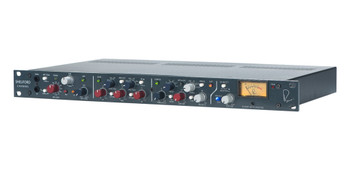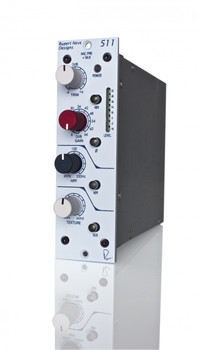Description
The Shelford 5052 echoes the simple and definitive 1073 feature set with a vertically-oriented mic pre, high pass filter, and 3-band inductor EQ, while also incorporating modern capabilities like the variable Silk / Texture control from the Portico II Series and simultaneous pre / post “tape” operation. Utilizing class-A, discrete, +/- 24V topologies with custom-wound transformers and inductors, Rupert Neve designed the 5052 as a vintage-style channel strip that captures the soul of his classic designs, without the previous compromises.
The Mic Pre
Like Rupert’s designs from his time in Shelford, the 5052 preamplifier has 72dB of discrete, class-A gain coupled with serious square-core transformers. Unlike the classics however, the output transformer features the Silk Red / Blue and Texture controls from the Portico II Series to hone the harmonic content and tonality of the output stage. By engaging these controls and sufficiently driving the output, the 5052 can produce up to 4-5% THD (primarily 2nd order, some 3rd order), bringing a richness and thickness to tracks when desired with no danger of overloading the output stage. With Silk disengaged, the output is modern and pristine, yet still retains Rupert’s signature larger-than-life transformer sound. The mic pre section also includes a sweepable 20-250Hz high-pass filter, Mic / Line selection, 48V phantom power, and polarity reverse.
Dual I/O Paths
Following the preamplifier, the 5052 has a transformer-coupled output, which allows the 5052 to feed a tape machine or DAW directly from the mic pre while still using the EQ and Silk / Texture in a dedicated analogue mix path such as that found with a 5088, 5060 or vintage console. This output can also be used to insert a separate compressor between the mic pre and the EQ, or it can allow the 5052 to work with two separate sources. When the “TO EQ” button is engaged, the mic pre signal is routed directly into the EQ such that the mic / line input signal flows through to the main output as a single channel strip.
The “best of the classics” EQ
The 3-band, custom-tapped inductor EQ on the 5052 was inspired by RND’s favorite portions of Rupert’s vintage EQ designs. The low frequency band is primarily based on the 1064, which is renowned for its creamy, resonant bass. Unlike the 1064 however, the LF band on the 5052 can be used as either a shelf or a peak filter, adding punch, dimension, and immense control to your low end. The 5052’s inductor midrange band is based on his prized 1073 EQ, which is ideal for sweetening vocals and instruments while bringing them forward in a mix. Additionally, the mid frequency band’s proportional “Q” response makes it well-suited for minimizing problematic frequencies in a source. The 5052’s high frequency band is a hybrid vintage / modern design, blending inductor circuitry from the 1073 with capacitor-based topologies to achieve the vintage tones with enhanced control. As Rupert originally intended with his most prized classic designs, each EQ section uses low-feedback, class-A discrete electronics to prevent low-level artifacts and harshness from detracting from the tonal shaping. The EQ circuit itself, however, is a decidedly modern updated design using techniques and components that were simply not available 35 years ago, and should not be considered a “clone”.
Power, Connections and Mounting
The 5052 receives +/- 24V rails from an external DC power supply using a 4-pin connection. There are currently two options available: the RND 5-way brick supply and the RND 25-way 2U rack-mount supply. The back panel of the 5052 includes three XLR-F connections for Mic In, Line In, and EQ In, and two XLR-M connections for Mic Out and Main Out. The 5052 chassis is a “half-rack” format, and can be mounted in RND’s new 2 –way and 4-way vertical racks in addition to the existing 9-way racks and the 5088 penthouse.
Silk / Texture
Pushing the Silk button cycles the silk modes from red silk to blue silk to off. Silk reduces the negative feedback on the output transformer, adding harmonic content as the texture is increased. Red Silk accentuates the saturation in the mid and high frequencies, similar to that of the red silk mode on the Portico II Channel. Blue Silk accentuates low frequencies. By manipulating the Texture control, the amount of Silk can be changed from essentially absent, to roughly 4-5% THD (mostly second order) depending on how hard the output transformer is being driven.
High Pass Filter
The high pass filter is continuously variable from 20-250Hz and engaged by the HPF switch, which illuminates when engaged. It is a valuable aid in any signal chain, but particularly so in a microphone preamplifier. Signals below the selected frequency are attenuated at a rate of 12db / octave, getting rid of proximity effect, building rumble, air handling, motor hum, etc.
Level Meter
An Eight-segment LED bar-graph meter displays output level (pre-Silk). The color range proceeds from green for lower level signals, yellow for intermediate signals, and red for high levels. When the 5052 is clipped, the highest red LED will hold longer depending on how far above the clip threshold the signal was.
Specifications
Frequency Response:
Main Output, no load, –3 dB @ 2.5 Hz –3 dB @ 125 kHz
Noise:
Measured at Main Output, unweighted, 22Hz-22kHz, Terminated 40 Ohms, With gain at unity better than –102 dBu
Maximum input:
from 20 Hz to 20 kHz, +25 dBu.
Maximum output:
from 20 Hz to 20 kHz is +25 dBu. Total Harmonic Distortion and Noise: from <10 Hz to 80 kHz, @ 1kHz, +20 dBu output: Better than 0.002% @ 20Hz, +20 dBu out Better than 0.120% 13 @ 20kHz, +20 dBu out Better than 0.010%
Equalizer
Noise:
Measured at Main Output, unweighted, 22Hz-22kHz, Terminated 40 Ohms. with all gains set at 0, Better than –92 dBu
Maximum input:
from 20 Hz to 20 kH, +24.5 dBu
Maximum output:
from 20 Hz to 20 kHz, +24.5 dBu Total Harmonic Distortion and Noise: from <10 Hz to 80 kHz, @ 1kHz, +20 dBu output: Better than 0.007% @ 20Hz, +20 dBu out Better than 0.120% @ 20kHz, +20 dBu out Better than 0.070%

















